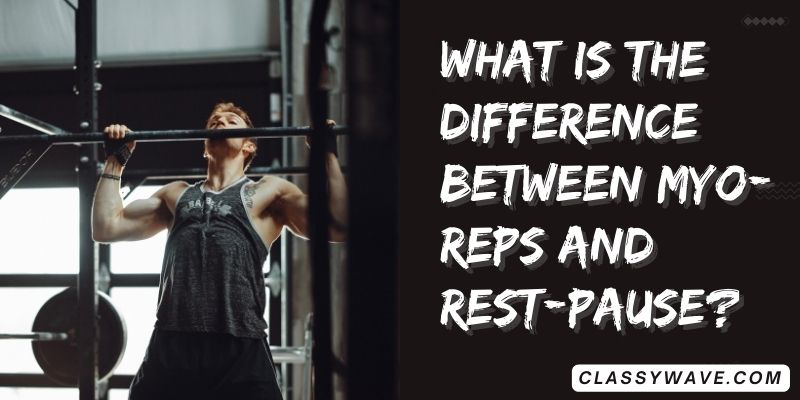What is the difference between Myo-Reps and rest-pause?
Embarking on an exploration of advanced training techniques, Myo-Reps and rest-pause, unveils nuanced strategies for optimizing muscle growth and strength. This comprehensive overview delves into the intricacies of each method, offering insights into customization, benefits, and considerations to empower individuals in enhancing their resistance training experience.
Myo-Reps Training Method Explained
Myo-Reps involve performing a compound exercise to near failure, followed by short rest periods and subsequent “activation” sets targeting the same muscle group. This time-efficient technique aims to maximize muscle fatigue and metabolic stress, promoting hypertrophy and strength gains. Understanding the principles of Myo-Reps ensures effective implementation in resistance training routines for individuals seeking an efficient and intense workout.
Understanding Rest-Pause Technique
Rest-pause training involves taking short breaks within a set, typically lasting 15-30 seconds, allowing partial recovery to extend a set beyond momentary failure. This technique enhances intensity, promoting both strength and hypertrophy by engaging muscle fibers more comprehensively. Mastering the rest-pause method provides individuals with a versatile tool for optimizing resistance training workouts and overcoming plateaus.
Comparing Myo-Reps vs. Rest-Pause
While both Myo-Reps and rest-pause share the goal of maximizing training efficiency and intensity, key differences exist. Myo-Reps focus on achieving metabolic stress through specific activation sets, emphasizing continuous tension. In contrast, rest-pause centers on brief inter-set recovery to extend overall set duration. Understanding these distinctions aids individuals in choosing the most suitable technique for their fitness goals.
Benefits of Myo-Reps for Strength and Hypertrophy
Myo-Reps offer several advantages, including increased time under tension, enhanced metabolic stress, and efficient muscle fiber recruitment. These benefits contribute to both hypertrophy and strength gains. Implementing Myo-Reps strategically in resistance training routines can optimize workout efficiency and promote well-rounded muscular development.
Advantages and Considerations in Rest-Pause
Rest-pause training provides unique advantages, such as extended set duration and enhanced muscle fiber activation. However, considerations include potential fatigue accumulation and the need for proper exercise selection. Balancing the benefits and considerations ensures effective integration into resistance training regimens, facilitating strength and hypertrophy gains.
Integrating Myo-Reps vs. Rest-Pause in Workouts
Integrating Myo-Reps or rest-pause techniques requires consideration of individual fitness goals, workout preferences, and training experience. Customizing their incorporation into resistance training routines ensures alignment with specific objectives, whether emphasizing hypertrophy, strength, or a balance of both. Individualization is key to optimizing the effectiveness of these advanced training methods.
Common Misconceptions
Misconceptions may surround both Myo-Reps and rest-pause training, impacting their proper implementation. Clarifying these misconceptions, such as understanding the specific activation sets in Myo-Reps or the optimal rest periods in rest-pause, ensures individuals harness the full benefits of these techniques while avoiding potential pitfalls.
Choosing Between Myo-Reps and Rest-Pause
The choice between Myo-Reps and rest-pause depends on individual preferences, fitness goals, and workout structure preferences. Recognizing the distinct characteristics of each technique and aligning them with personal objectives allows individuals to make informed decisions, optimizing the effectiveness of their resistance training routines.
Targeting Specific Muscle Groups with Myo-Reps
Tailoring Myo-Reps to specific muscle groups involves adjusting exercise selection and activation sets. Focusing on muscle isolation allows for a more nuanced and targeted approach, optimizing the benefits of metabolic stress and continuous tension. This customization ensures efficient muscle engagement and growth in desired areas, contributing to a well-rounded and sculpted physique.
Fine-Tuning Rest-Pause for Maximum Results
Maximizing results with rest-pause requires precise fine-tuning. Adjusting rest intervals, exercise selection, and understanding individual recovery capacity are crucial aspects. This meticulous approach ensures that each rest-pause set effectively challenges muscle fibers, promoting strength and hypertrophy gains while minimizing the risk of overtraining.
Adapting to Different Fitness Levels
Myo-Reps can be adapted to different fitness levels by adjusting the intensity and volume. Beginners may start with lighter weights and fewer activation sets, gradually progressing. Advanced individuals can push closer to failure with heavier weights and additional activation sets. This adaptability ensures Myo-Reps are accessible and challenging for individuals at varying stages of their fitness journey.
Rest-Pause
Tailoring rest-pause intensity involves balancing the number of rest intervals and the load lifted. For hypertrophy, shorter rests with moderate loads may be beneficial, while strength-focused goals may require longer rests with heavier weights. Customizing rest-pause allows individuals to align this technique with specific goals, optimizing its application in resistance training routines.
Combining Myo-Reps and Rest-Pause for Versatile Workouts
Combining Myo-Reps and rest-pause introduces versatility to resistance training workouts. This synergy allows individuals to leverage the strengths of each technique, promoting comprehensive muscle engagement, metabolic stress, and extended set durations. Integrating these methods strategically into a workout routine provides a dynamic and effective approach to achieving diverse fitness objectives.
Conclusion
In conclusion, the dynamic interplay between Myo-Reps and rest-pause techniques introduces a spectrum of possibilities for tailored resistance training. Understanding the intricacies of each method empowers individuals to craft workouts aligned with their unique goals, preferences, and fitness levels. Whether seeking targeted muscle engagement, fine-tuned intensity, or a versatile approach, the synergy of Myo-Reps and rest-pause provides a sophisticated toolkit for advancing one’s fitness journey with precision and efficacy.
FAQs
1. Question: How can I determine the ideal rest intervals for rest-pause sets to maximize muscle growth and minimize fatigue?
Answer: Tailor rest intervals based on personal recovery capacity, aiming for effective muscle engagement without excessive fatigue.
2. Question: What considerations should I keep in mind when targeting specific muscle groups with Myo-Reps?
Answer: Adjust exercise selection and activation sets to focus on muscle isolation, ensuring targeted engagement and growth.
3. Question: Can beginners effectively incorporate Myo-Reps into their routines, and how should they adapt the technique?
Answer: Yes, start with lighter weights and fewer activation sets, gradually progressing to challenge muscle fibers effectively.
4. Question: Is it possible to combine Myo-Reps and rest-pause in a single workout, and what benefits does this offer?
Answer: Yes, combining both techniques provides a versatile approach, leveraging the strengths of each for comprehensive muscle engagement and growth.
5. Question: How do nutritional considerations differ for Myo-Reps and rest-pause training, and how can I optimize my diet accordingly?
*Answer: Prioritize protein intake for muscle recovery. Adjust calorie intake based on workout intensity and individual energy needs.







